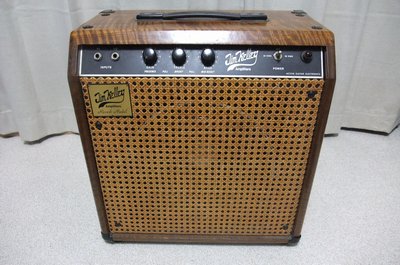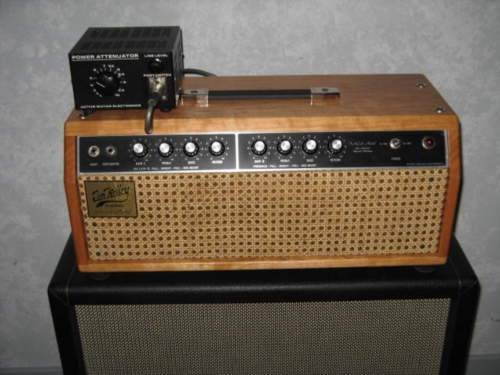Jim Kelley was a small manufacturer of boutique amps who started his business in the late 70ies. He started with only one amp model, a single channel amp with 6 tubes and just 3 knobs. The later dual channel was still based on this model.
Compared to other boutique amp that were favourits at that time – namely Mesa Boogie or Dumble – the Kelley amps followed a different approach. While the Mesa Boogies had lots of controls and options (various push/pull knobs, EQs, different gain stages etc.), the Kelley had just 3 knobs and followed the idea of having a simple signal path without any redundant components to obtain a pure and natural sound.

While the Mesa Boogie made use of two different pre-amp sections that were chained in serial so that the first can overdrive the second to get high-gain distortion even at low volume, the Kelley favoured the more natural sounding distortion from the power amp. As this automatically results in high volume, the amps were often paired with a power attenuator ( a device between amp and speakers that turns a part of the output power into heat to reduce volume).
The Kelley amps soon get very popular among session players on the US West Coast, they became the “house amplifiers” of the Shangri La studios (the place where Mark Knopfler recorded his Shangri La album decades later), and were soon exported to Japan and Gemany (by the way, the German distributor was the music shop in my hometown where I played a Kelley amp for the first time in the early 80ies). On the US East Coast they were sold at Rudy’s Music Stop in New York, where John Suhr and Jack Sonni worked at that time, who introduced this amp to Mark Knopfler. According to Jack Sonni, Mark played his Kelley amp and his foam green Schecter Strat for the recording of One World (from the Brothers in Arms album) and loved the sound so much that he used the Kelley amp on the Brothers in Arms tour (1985/86).

The model Jack Sonni and Mark Knopfler used was the dual channel amp, the FACS (for foot activated channel switching). These amps were available as combo or head (Knopfler and Sonni used the heads) and had two identical pre amps so that each can be adjusted for a different sound, with a reverb control for each channel. As the idea of the Kelley’s distortion sound was to overdrive the output stage, different gain settings would automatically lead to different volume. Here the attenuator comes in, which was activated when switching to the overdriven channel so that you can match the volume to your needs.
Technical stuff
Each channel has a gain, treble, bass, and reverb control (from left to right). The treble control can be pulled to act as a bright switch, while pulling the bass control adds a mid boost. Pulling the gain control on channel one – which was intended as a the overdrive channel and is paired with tghe power attenuator – allows you to switch the channels without the foot switch, pulling out the gain control of the second channel enables a presence boost.
The output stage uses four 6V6 tubes and can be switched to 30 or 60 watts, while 12AX7 tubes were used in the pre , as phase inverter, and to drive the reverb. The Brothers in Arms tour was one of the longest tours a major rock band ever did, and thus surely meant a particular stress for the gear. This lead to some tube failures so that Jack Sonni finally changed to a Seymour Duncan convertable amp towards the end of the tour which seems more reliable.

Unfortunately there aren’t any pictures that show Mark’s amps as these were placed behind the stage where they could be operated by a technician. You can see one of these – probably Jack Sonni’s – on the video of the Live Aid concert in July 1985. The pictures do not show Knopfler’s amp but similar ones.

2 thoughts on “Jim Kelley amps – the FACS model used on the Brothers in Arms tour”
Hi all,
Suhr Guitars is now selling a Jim Kelley Single Channel 60W combo or head, Limited Edition.
http://www.suhrguitars.com/JimKelley.aspx
The info on the web page is nice and it is including some good videos of different settings and also about the attenuator.
It is interesting to notice that the speaker fitted is an ElectroVoice EVM12L.
Enjoy!!!
Eduard.
Right, I also just found out, a bit after publishing the article but you were faster than me 🙂